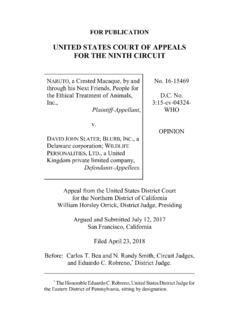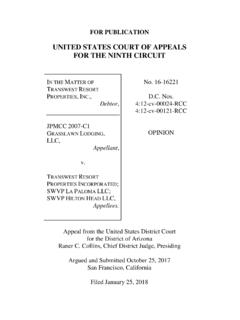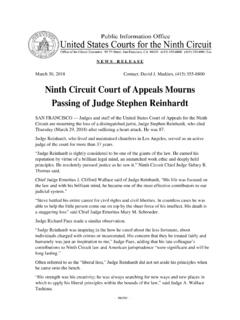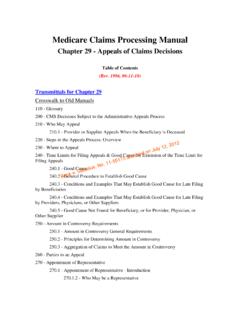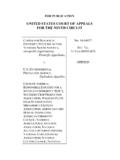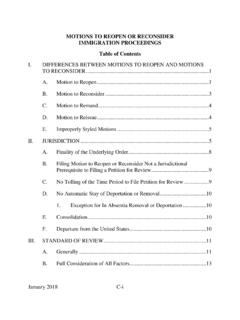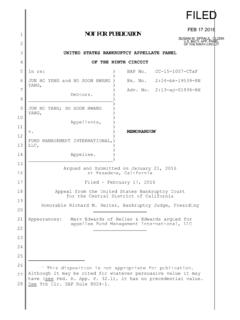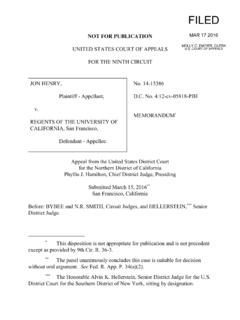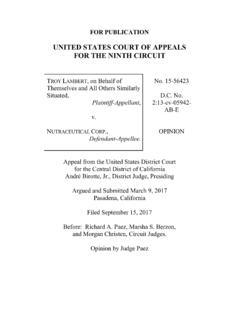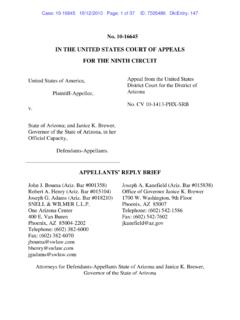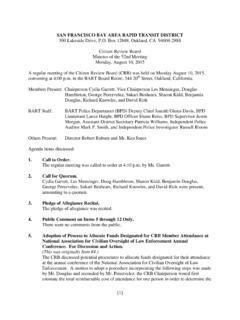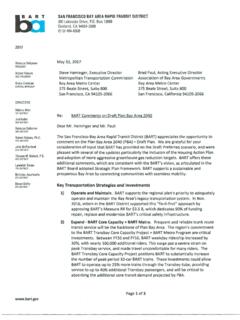Transcription of D.C. No.
1 FOR PUBLICATIONUNITED STATES COURT OF APPEALSFOR THE NINTH CIRCUIT SHERON GEORGE; SHARRICCIFOURTE-DANCY,No. 07-15661 Plaintiffs-Appellees, area rapid transit ,Defendant-Appellant. SHERON GEORGE; SHARRICCIFOURTE-DANCY,Plaintiffs-Appelle es,No. 07-15896 UNITED STATES OF AMERICA, No. Appellant, area rapid transit ,Defendant. Appeal from the United States District Courtfor the Northern District of CaliforniaClaudia Wilken, District Judge, PresidingArgued September 11, 2008 Submitted August 5, 2009 San Francisco, CaliforniaFiled August 13, 2009 Before: Diarmuid F. O Scannlain, Ronald M. Gould andCarlos T. Bea, Circuit by Judge O Scannlain10923 COUNSELP atricia Barbosa, Law Offices of Paul L. Rein, Oakland, Cali-fornia argued the cause for plaintiffs-appellees and filed abrief.
2 Paul Rein and Julie Ostel, Law Offices of Paul L. Rein,Oakland, California, and Bryce Anderson, Law Office ofBryce Anderson, Brentwood, California were on the Hearst, Berkeley, California argued the cause for BayArea rapid transit and filed briefs. Clement Glynn and JamesHanlon, Glynn & Finley LLP, Walnut Creek, California wereon the Gellert, Department of Justice, Washington, ,argued the cause for intervenor-appellant and filed the v. BAY area rapid TRANSITRena Comisac, Acting Assistant Attorney General, and MarkGross were on the SCANNLAIN, Circuit Judge:We must decide whether sight-impaired transit riders canrecover under the Americans with Disabilities Act where apublic transit service system complies with existing federaldesign regulations for train station George had congenital cataracts.
3 By 1998, hervision had become impaired to the point that she was declaredlegally George valued her independence, and becauseshe could not drive, relied on services provided by Bay AreaRapid transit District ( BART ) and other public transporta-tion services to get around. She found it particularly difficultto negotiate stairs because of her limited depth , she was able to use stairs if they were painted ormarked a different color to show the location of each was taught to follow the movement of others to avoid get-ting lost when she entered or exited public places. She hadnever attempted to use BART s so-called accessible or uni-versal routes in its train day, George was walking from a bus to a BART trainstation when she fell down a set of stairs.
4 She reported that1 George has since died; her personal representative is continuing thiscase. 10927 GEORGE v. BAY area rapid TRANSITshe did not see any markings or any other indication that[she] was approaching a stair until [she] suddenly stepped offinto thin air. She also noted that she was in great pain as aresult of her fall and was taken to the hospital the next days later, George fell again when she attempted to usewhat was (unbeknownst to her) a closed entrance. She statedin an affidavit that she was severely hurt and asked BART tocall an s eyesight improved in 2001 to the point that shewas no longer legally blind. However, she reported that afterher falls she developed physical disabilities that significantlyimpaired her mobility and was prescribed a wheelchair due tothose Fourte-Dancy2 had partial sight in both eyes, withcorrected vision of 20/200 in one eye and 20/100 in the depth perception and peripheral vision were limited; hernight vision was even more significantly impaired.
5 As of2002, she was a student at California State University at Hay-ward and used public transportation (including BART) toattend school and for other purposes. She reported anxietywhen using some of BART s stations because they were notequipped with color contrast striping or accessible did not have the visual acuity necessary to locate a desig-nated accessible route on her own because she could not readsigns in public places unless she was very close to reported feeling unsafe when isolated from thegeneral public, and stated that the BART elevators she knewof were too isolated. For these two reasons, she would notand [could not] use the universal route that BART claims2 Fourte-Dancy s name is spelled differently in some district court docu-ments.
6 We use the spelling used by her counsel in this case. 3 The facts recited were true as of April 25, 2002. We are unaware ofFourte-Dancy s current status. 10928 GEORGE v. BAY area rapid TRANSITwas intended and designed for blind and low vision persons. She reported, however, that she could use facilities with afew minor modifications, such as color contrast striping andaccessible handrails. Fourte-Dancy reported that the lack of color contrast strip-ing and the excessively wide handrails almost caused her tofall at BART s MacArthur train station. She also reported thatthe glare from the color contrast steps at the 19th Street sta-tion also caused her difficulty in using the and Fourte-Dancy (to whom we refer as transitriders ) sued BART in the United States District Court for theNorthern District of California, alleging violations of theAmericans with Disabilities Act ( ADA ), the RehabilitationAct of 1973, and California civil rights In the district court, both sides agreed that BART s facili-ties complied with the Department of Transportation ( DOT )regulations, which require that each light rail station have atleast one accessible route from an accessible entrance to thoseareas necessary for the use of the transportation system.
7 56 Fed. Reg. 45,500, 45,510 (Sept. 6, 1991). DOT regulationsare required by statute to be consistent with the ADA Accessi-bility Guidelines ( ADAAG ) in effect at the time. Such spe-cific technical guidelines implementing the ADA are issuedby the Architectural and Transportation Barriers ComplianceBoard ( Board ), an independent Nevertheless, the4 Four of BART s stations must meet certain requirements imposed bythe ADA. After the passage of the ADA, each of these stations was modi-fied to provide a route for individuals with disabilities. The transit ridersclaim that the routes do not meet the needs of visually disabled Board has thirteen members appointed by the President from thegeneral public (of whom at least seven must be persons with disabilities)and a representative from each of twelve federal agencies.
8 29 v. BAY area rapid transit district court found that such DOT regulations were botharbitrary and plainly contrary to the statute. Because theADA requires that public transportation programs be accessi-ble to all patrons with disabilities, [t]he DOT regulationsare arbitrary and capricious to the extent that they fail to ful-fill this mandate by failing to address the needs of those withvisual impairments. A stipulated judgment required BART topay attorney s fees and costs, as well as $35,000 in compensa-tory damages. In addition, BART was required to take sevenspecific steps to improve the accessibility of some of its facili-ties to those with vision impairments. BART appealed the district court s decision to this court,whereupon the United States was granted leave to file a briefas amicus curiae.
9 On April 21, 2006, we vacated the districtcourt s decision and remanded the case to the district court sothe United States could intervene as a party, which the UnitedStates promptly did. See George v. Bay area rapid TransitDist., 175 F. App x 809 (9th Cir. 2006). Following remand,the district court again found the DOT regulations to be arbi- 792. Congress directed the Board to publish minimum accessibilityguidelines. 42 12204. The Department of Transportation wasrequired to make its regulations consistent with those guidelines. 12149(b). In 1991, the Board issued the ADAAG after receivingover 400 comments, including comments about individuals with visualdisabilities. For instance, the Board received comments about the use oflarge characters on signs, design criteria for use in aiding those with visualdisabilities, and other matters.
10 56 Fed. Reg. 45,500, 45,503 (Sept. 6,1991). DOT then issued its ADA regulations. DOT s regulations are consistentwith the Board s guidelines. 49 ( [A] transportation facilityshall be considered to be readily accessible to and usable by individualswith disabilities if it meets the requirements of this part and the require-ments set forth in Appendices B and D to 36 CFR part 1191 [ , theADAAG requirements], which apply to buildings and facilities covered bythe Americans with Disabilities Act, as modified by Appendix A to thispart. ). 10930 GEORGE v. BAY area rapid transit trary and capricious. BART and the United States both nowtimely United States argues that the district court erred bydeclaring the DOT regulatory scheme arbitrary and was required to issue regulations to make key sta-tions readily accessible to and useable by persons with visualimpairments.
